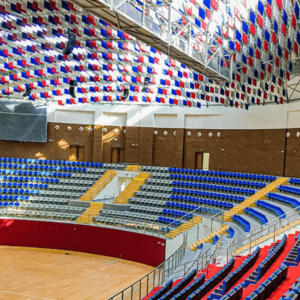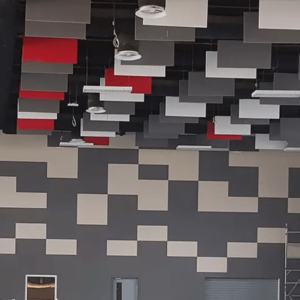Absorption Eggcrate Acoustic Foam Panels
Enhance sound absorption with the unique sound wave pattern. Eggcrate Acoustic Foam Panels at Gitco-sa.com feature a unique shape for superior sound control. Lightweight, fiber-free, and easy to install in studios, offices, classrooms, and more. Explore our range of thicknesses and sizes.
Description
Polyurethane Eggcrate Acoustic Foam Panels available at Gitco-sa.com feature a distinctive, convoluted surface that significantly improves sound absorption compared to traditional flat surfaces. This unique shape, resembling an eggcrate or sound wave pattern, maximizes the absorptive surface area, making these panels high-performance sound absorbers effective across a broad range of frequencies. Constructed from open-cell polyurethane acoustic foam, they are fiber-free and lightweight, ensuring easy handling and installation for optimal acoustic treatment in various environments.
Acoustic foam works by increasing air resistance, converting sound energy into heat, and thus attenuating airborne sound waves. These Eggcrate Acoustic Foam Panels can be easily applied to walls, ceilings, and other surfaces to dramatically enhance speech privacy and intelligibility by reducing noise levels, vibration, and echoes.
Applications Of Eggcrate Acoustic Foam:
These acoustic panels are perfect for any space where good speech privacy or speech intelligibility is important, including:
- Offices
- Schools
- Meeting Rooms
- Hotels
- Auditoriums
- Recording Studios
- Conference Halls
- Broadcasting Studios
Product Details Of Eggcrate Acoustic Foam:
- Core: Open Cell Polyurethane Acoustical Foam
- Thickness (mm): 35mm, 50mm; custom thicknesses available
- Sizes (mm): 600mm x 600mm, 1200mm x 1200mm, 1000mm x 2000mm, custom sizes available
- Acoustic Properties: NRC 0.82 – 0.96 (varies with thickness and mounting)
- Density: 1 lbs/cub.ft, 2 lbs/cub.ft
- Colours: Charcoal Grey
- Flammability: Meets UL94 HF -1 Standard
- Mounting type: Type A
- Installation: Recommended with ASI S.T.O.P Noise Acoustical Adhesive or any suitable construction adhesive
Understanding Eggcrate Acoustic Foam:
- What is egg crate acoustic foam?
- It’s a type of sound-absorbing foam panel made from polyurethane or sometimes melamine foam, featuring a surface with raised peaks and recessed troughs resembling an egg carton.
- How does eggcrate acoustic foam work?
- The open-cell structure of the foam absorbs sound energy by converting it into heat as sound waves travel through the material. The uneven surface increases the surface area compared to flat foam, potentially enhancing mid to high-frequency absorption.
- What are the primary benefits of using eggcrate acoustic foam?
- Cost-effective acoustic treatment option, lightweight and easy to install, recognizable and somewhat distinctive in appearance and with some level of sound absorption, particularly in the mid and high frequencies.
- Where is eggcrate acoustic foam commonly used?
- Budget home studios, vocal booths, rehearsal spaces, sound dampening for computer equipment, lining cases or enclosures, and in situations where basic sound absorption is needed without a high aesthetic requirement.
- What materials are eggcrate acoustic foam made from?
- Primarily polyurethane foam (most common and affordable) or sometimes melamine foam (more fire-resistant but less common in this shape).
- What are the standard sizes and thicknesses of eggcrate acoustic foam?
- Common sizes include sheets of varying dimensions (e.g., 12×12 inches, 24×48 inches). Thickness is often described by the overall thickness, including the peaks (e.g., 1 inch, 2 inches). The base thickness and peak height contribute to the overall dimension.
- How does eggcrate acoustic foam compare to other acoustic foam shapes (e.g., wedge, pyramid, flat)?
- Eggcrate foam is often considered a less efficient absorber compared to wedge or pyramid shapes of similar overall thickness because the peaks are generally less dense and have less mass. Flat foam of similar thickness might offer comparable basic absorption.
- What is the Noise Reduction Coefficient (NRC) range for eggcrate acoustic foam?
- The NRC rating varies depending on the foam’s density and overall thickness, but it’s generally in the lower to mid-range compared to denser or geometrically optimized foam shapes, typically ranging from 0.40 to 0.70.
Selecting and Specifying Eggcrate Acoustic Foam:
- Is eggcrate foam effective for treating low frequencies (bass)?
- Eggcrate foam is generally not very effective at absorbing low frequencies due to its typically thinner base and less dense peaks. Thicker and specifically designed bass traps are needed for bass control.
- How much eggcrate foam do I need for my room?
- This depends on the room’s size and the desired level of sound absorption. For basic dampening, covering a significant portion of the walls and ceiling can be considered. For more critical applications, other foam shapes might be more efficient.
- What is the difference between polyurethane and melamine eggcrate foam?
- Polyurethane eggcrate foam is more common and affordable but flammable. Melamine eggcrate foam offers better fire resistance but is less readily available in this shape and might be more expensive.
- Is eggcrate foam easy to cut or modify?
- Yes, it can be easily cut to size or shape using scissors or a utility knife.
- What are the common ways to mount eggcrate foam?
- Common methods include using spray adhesive, double-sided tape, or construction adhesive. Removable options might be less secure due to the uneven surface.
- Does eggcrate foam block sound from traveling through walls?
- No, acoustic foam primarily absorbs sound within a room. It does not provide significant soundproofing or block sound transmission to adjacent rooms.
Installation and Maintenance of Eggcrate Acoustic Foam:
- How do I install eggcrate foam for optimal effectiveness?
- Focus on treating primary reflection points. The peaks should face the room to maximize surface area exposure to sound waves.
- Should I cover all the walls and ceiling with eggcrate foam?
- Over-treating with any foam can lead to a “dead” sounding room. Start with key reflection points and assess the sound before adding more. For critical listening environments, consider a combination of different acoustic treatments.
- How do I clean eggcrate foam?
- Gentle vacuuming with a soft brush attachment is the best way to remove dust. The convoluted surface can trap dust more easily. Avoid liquids or harsh chemicals.
- Does eggcrate foam degrade or lose its effectiveness over time?
- Like other polyurethane foams, it can degrade over time, especially with exposure to UV light, causing discoloration and potentially becoming brittle.
Purchasing and Cost of Eggcrate Acoustic Foam:
- Where can I buy eggcrate acoustic foam?
- It is available in Gitco. Gitco is a foam supplier and some budget-oriented acoustic treatment stores like Gitco Store. It’s often sold in large rolls or multi-panel packs.
- How much does eggcrate acoustic foam cost?
- Eggcrate foam is generally one of the most affordable types of acoustic foam, making it a popular choice for budget-conscious individuals or temporary setups. Prices vary by size, thickness, and material.
Achieve superior sound absorption and improve the acoustic quality of your space with the high-performing Eggcrate Acoustic Foam Panels from Gitco-sa.com. Explore our range of thicknesses and sizes to find the ideal solution for your specific acoustic treatment requirements.
Additional information
| Applied on | Ceiling, Wall |
|---|---|
| Material Type | Polyurethane (PU) |
| Core | Open Cell Polyurethane Acoustical Foam |
|---|---|
| Thickness (mm) | 35mm, 50mm ;custom thicknesses are also available |
| Sizes (mm) | 600mm x 600mm, 1200mm x 1200mm, 1000mm x 2000mm & also custom sizes |
| Acoustic Properties | NRC 0.82 – 0.96 ( varies with thickness and mounting ) |
| Density | 1lbs/cub.ft, 2 lbs/cub.ft |
| Colours | Charcoal Grey |
| Flamability | Meets UL94 HF -1 Standard |
| Mounting type | Type A |
| Installation | ASI S.T.O.P Noise Acoustical Adhesive or any construction adhesive |
Sound Absorption Coefficients
| Thickness | 125Hz | 250Hz | 500Hz | 1KHz | 2KHz | 4KHz | NRC |
|---|---|---|---|---|---|---|---|
| 35mm | 0.03 | 0.32 | 0.88 | 1.09 | 0.98 | 0.93 | 0.82 |
| 50mm | 0.08 | 0.63 | 1.11 | 1.07 | 1.04 | 0.97 | 0.96 |










Reviews
There are no reviews yet.